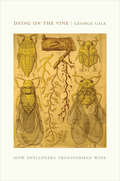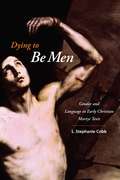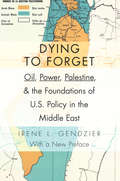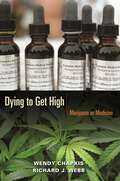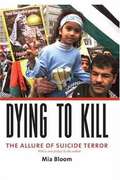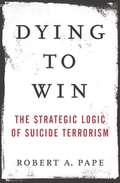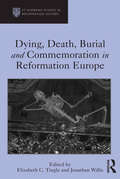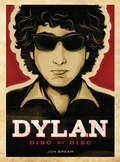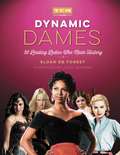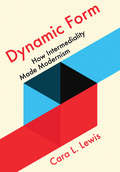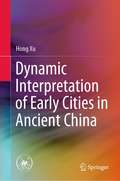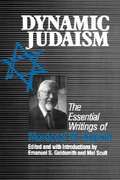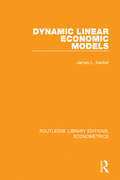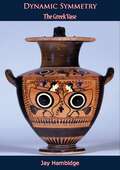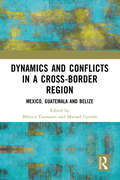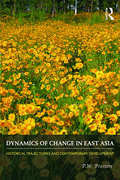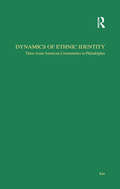- Table View
- List View
Dying of Money: Lessons of the Great German and American Inflations
by Jens O. ParssonThe twentieth century brought the institution of inflation to its ultimate perfection. When economic systems are so highly organized as they became in the twentieth century, so that people are completely dependent on money trading for the necessaries of life, there is no place to take shelter from inflation. Inflations in the twentieth century became like inflations in no other century. The two principal inflations that occurred in advanced industrial nations in the twentieth century will probably prove to have done more to influence the course of history itself than any other inflation. One of these was the German inflation that had its roots in World War I, grew to a giddy height and a precipitous fall in 1923, and contributed to the rise of Adolf Hitler and World War II. The other was the great American inflation that had its roots in World War II, grew in the decade of the 1960's toward an almost equally giddy height, and contributed to results which could not even be imagined at the time this book was written.
Dying on the Vine: How Phylloxera Transformed Wine
by George D. Gale Jr.Dying on the Vine chronicles 150 years of scientific warfare against the grapevine's worst enemy: phylloxera. In a book that is highly relevant for the wine industry today, George Gale describes the biological and economic disaster that unfolded when a tiny, root-sucking insect invaded the south of France in the 1860s, spread throughout Europe, and journeyed across oceans to Africa, South America, Australia, and California--laying waste to vineyards wherever it landed. He tells how scientists, viticulturalists, researchers, and others came together to save the world's vineyards and, with years of observation and research, developed a strategy of resistance. Among other topics, the book discusses phylloxera as an important case study of how one invasive species can colonize new habitats and examines California's past and present problems with it.
Dying to Be Men: Gender and Language in Early Christian Martyr Texts (Gender, Theory, and Religion)
by L. Stephanie CobbAt once brave and athletic, virtuous and modest, female martyrs in the second and third centuries were depicted as self-possessed gladiators who at the same time exhibited the quintessentially "womanly" qualities of modesty, fertility, and beauty. L. Stephanie Cobb explores the double embodiment of "male" and "female" gender ideals in these figures, connecting them to Greco-Roman virtues and the construction of Christian group identities. Both male and female martyrs conducted their battles in the amphitheater, a masculine environment that enabled the divine combatants to showcase their strength, virility, and volition. These Christian martyr accounts also illustrated masculinity through the language of justice, resistance to persuasion, and-more subtly but most effectively-the juxtaposition of "unmanly" individuals (usually slaves, the old, or the young) with those at the height of male maturity and accomplishment (such as the governor or the proconsul). Imbuing female martyrs with the same strengths as their male counterparts served a vital function in Christian communities. Faced with the possibility of persecution, Christians sought to inspire both men and women to be braver than pagan and Jewish men. Yet within the community itself, traditional gender roles had to be maintained, and despite the call to be manly, Christian women were expected to remain womanly in relation to the men of their faith. Complicating our understanding of the social freedoms enjoyed by early Christian women, Cobb's investigation reveals the dual function of gendered language in martyr texts and its importance in laying claim to social power.
Dying to Forget
by Irene L. GendzierIn her groundbreaking analysis of the origins and evolution of U.S. policy toward the Middle East from 1945 to 1949, Irene L. Gendzier presents incontrovertible evidence that oil politics played a significant role in the founding of Israel, the policy adopted by the United States toward Palestinians, and subsequent U.S. involvement in the region. Consulting declassified U.S. government sources, as well as papers in the H.S. Truman Library, Gendzier uncovers little-known features of U.S. involvement in the region, including significant exchanges in the winter and spring of 1948 between the director of the Oil and Gas Division of the Interior Department and the representative of the Jewish Agency in the United States, months before Israel's independence and recognition by President Truman. She also shows that U.S. consuls and representatives abroad informed State Department officials, including the Secretary of State and the President, of the deleterious consequences of partition in Palestine. In documenting this dimension of U.S. policy, her work complements that of Palestinian historians as well as Israel's "New Historians" of 1948. The attempt to reconsider partition and replace it with a UN trusteeship for Palestine failed, however, jettisoned by Israel's declaration of independence. The results altered the regional balance of power and Washington's calculations of policy toward the new state. Prior to that, as Gendzier's work reveals, the U.S. endorsed the repatriation of Palestinian refugees in accord with UNGA Res 194 of Dec. 11, 1948, in addition to the resolution of territorial claims, the definition of boundaries, and the internationalization of Jerusalem. Yet instead of implementing the resolutions U.S. officials insisted were key to resolving the conflict, the United States deferred to Israel to assure its pro-Western support in the protection of U.S. oil interests in the Middle East.
Dying to Forget: Oil, Power, Palestine, and the Foundations of U.S. Policy in the Middle East
by Irene GendzierIrene L. Gendzier presents incontrovertible evidence that oil politics played a significant role in the founding of Israel, the policy then adopted by the United States toward Palestinians, and subsequent U.S. involvement in the region. Consulting declassified U.S. government sources, as well as papers in the H.S. Truman Library, she uncovers little-known features of U.S. involvement in the region, including significant exchanges in the winter and spring of 1948 between the director of the Oil and Gas Division of the Interior Department and the representative of the Jewish Agency in the United States, months before Israel's independence and recognition by President Truman. Gendzier also shows that U.S. consuls and representatives abroad informed State Department officials, including the Secretary of State and the President, of the deleterious consequences of partition in Palestine. Yet the attempt to reconsider partition and replace it with a UN trusteeship for Palestine failed, jettisoned by Israel's declaration of independence. The results altered the regional balance of power and Washington's calculations of policy toward the new state. Prior to that, Gendzier reveals the U.S. endorsed the repatriation of Palestinian refugees in accord with UNGA Res 194 of Dec. 11, 1948, in addition to the resolution of territorial claims, the definition of boundaries, and the internationalization of Jerusalem. But U.S. interests in the Middle East, notably the protection of American oil interests, led U.S. officials to rethink Israel's military potential as a strategic ally. Washington then deferred to Israel with respect to the repatriation of Palestinian refugees, the question of boundaries, and the fate of Jerusalem—issues that U.S. officials have come to realize are central to the 1948 conflict and its aftermath.
Dying to Get High: Marijuana as Medicine
by Wendy Chapkis Richard J. WebbAn inside look at how patients living with terminal illness created one of the country’s first medical marijuana collectivesMarijuana as medicine has been a politically charged topic in this country for more than three decades. Despite overwhelming public support and growing scientific evidence of its therapeutic effects (relief of the nausea caused by chemotherapy for cancer and AIDS, control over seizures or spasticity caused by epilepsy or MS, and relief from chronic and acute pain, to name a few), the drug remains illegal under federal law. In Dying to Get High, noted sociologist Wendy Chapkis and Richard J. Webb investigate one community of seriously-ill patients fighting the federal government for the right to use physician-recommended marijuana. Based in Santa Cruz, California, the Wo/Men’s Alliance for Medical Marijuana (WAMM) is a unique patient-caregiver cooperative providing marijuana free of charge to mostly terminally ill members. For a brief period in 2004, it even operated the only legal non-governmental medical marijuana garden in the country, protected by the federal courts against the DEA.Using as their stage this fascinating profile of one remarkable organization, Chapkis and Webb tackle the broader, complex history of medical marijuana in America. Through compelling interviews with patients, public officials, law enforcement officers and physicians, Chapkis and Webb ask what distinguishes a legitimate patient from an illegitimate pothead, good drugs from bad, medicinal effects from just getting high. Dying to Get High combines abstract argument and the messier terrain of how people actually live, suffer and die, and offers a moving account of what is at stake in ongoing debates over the legalization of medical marijuana.
Dying to Kill: The Allure of Suicide Terror
by Mia BloomWhat motivates suicide bombers in Iraq and around the world? Can winning the hearts and minds of local populations stop them? Will the phenomenon spread to the United States? These vital questions are at the heart of this important book. Mia Bloom examines the use, strategies, successes, and failures of suicide bombing in Asia, the Middle East, and Europe and assesses the effectiveness of government responses. She argues that in many instances the efforts of Israel, Russia, and the United States in Iraq have failed to deter terrorism and suicide bombings. Bloom also considers how terrorist groups learn from one another, how they respond to counterterror tactics, the financing of terrorism, and the role of suicide attacks against the backdrop of larger ethnic and political conflicts. Dying to Kill begins with a review of the long history of terrorism, from ancient times to modernity, from the Japanese Kamikazes during World War II, to the Palestinian, Tamil, Iraqi, and Chechen terrorists of today. Bloom explores how suicide terror is used to achieve the goals of terrorist groups: to instill public fear, attract international news coverage, gain support for their cause, and create solidarity or competition between disparate terrorist organizations. She contends that it is often social and political motivations rather than inherently religious ones that inspire suicide bombers. In her chapter focusing on the increasing number of women suicide bombers and terrorists, Bloom examines Sri Lanka, where 33 percent of bombers have been women; Turkey, where the PKK used women feigning pregnancy as bombers; and the role of the Black Widows in the Chechen struggle against Moscow. The motives of individuals, whether religious or nationalist, are important but the larger question is, what external factors make it possible for suicide terrorism to flourish? Bloom describes these conditions and develops a theory of why terrorist tactics work in some instances and fail in others.
Dying to Learn: Wartime Lessons from the Western Front (Cornell Studies in Security Affairs)
by Michael A. HunzekerIn Dying to Learn, Michael Hunzeker develops a novel theory to explain how wartime militaries learn. He focuses on the Western Front, which witnessed three great-power armies struggle to cope with deadlock throughout the First World War, as the British, French, and German armies all pursued the same solutions-assault tactics, combined arms, and elastic defense in depth. By the end of the war, only the German army managed to develop and implement a set of revolutionary offensive, defensive, and combined arms doctrines that in hindsight represented the best way to fight.Hunzeker identifies three organizational variables that determine how fighting militaries generate new ideas, distinguish good ones from bad ones, and implement the best of them across the entire organization. These factors are: the degree to which leadership delegates authority on the battlefield; how effectively the organization retains control over soldier and officer training; and whether or not the military possesses an independent doctrinal assessment mechanism.Through careful study of the British, French, and German experiences in the First World War, Dying to Learn provides a model that shows how a resolute focus on analysis, command, and training can help prepare modern militaries for adapting amidst high-intensity warfare in an age of revolutionary technological change.
Dying to Live
by Mizue Aizeki Joseph NevinsPraise for A Not-So-Distant Horror:"[A] remarkable book."--Noam ChomskyTold through the life story of a young man who perished in the California desert, Dying to Live is a compelling account of US immigration/border enforcement and the rapidly growing death toll among migrants. Stunning photos by Mizue Aizeki complement the text.Joseph Nevins authored Operation Gatekeeper: The Rise of the Illegal Alien and the Making of the U.S.-Mexico Boundary (Routledge, 2002), and A Not-So-Distant Horror (Cornell, 2005). His writings have appeared in the Boston Review, The Christian Science Monitor, and the International Herald Tribune.
Dying to Win: The Strategic Logic of Suicidal Terrorism
by Robert A. PapeIn the most comprehensive survey of suicide terrorism ever undertaken, Professor Robert Pape has collected details of every attack from 1980 to 2003, from Arabic, Hebrew, Tamil, and Russian language sources (as well as English), including primary documents from the suicide terrorist groups themselves. This comprehensive information provides a startling new window into the origins, conduct, and consequences of suicide terrorism.
Dying, Death, Burial and Commemoration in Reformation Europe (St Andrews Studies in Reformation History)
by Elizabeth C. Tingle Jonathan WillisIn recent years, the rituals and beliefs associated with the end of life and the commemoration of the dead have increasingly been identified as of critical importance in understanding the social and cultural impact of the Reformation. The associated processes of dying, death and burial inevitably generated heightened emotion and a strong concern for religious propriety: the ways in which funerary customs were accepted, rejected, modified and contested can therefore grant us a powerful insight into the religious and social mindset of individuals, communities, Churches and even nation states in the post-reformation period. This collection provides an historiographical overview of recent work on dying, death and burial in Reformation and Counter-Reformation Europe and draws together ten essays from historians, literary scholars, musicologists and others working at the cutting edge of research in this area. As well as an interdisciplinary perspective, it also offers a broad geographical and confessional context, ranging across Catholic and Protestant Europe, from Scotland, England and the Holy Roman Empire to France, Spain and Ireland. The essays update and augment the body of literature on dying, death and disposal with recent case studies, pointing to future directions in the field. The volume is organised so that its contents move dynamically across the rites of passage, from dying to death, burial and the afterlife. The importance of spiritual care and preparation of the dying is one theme that emerges from this work, extending our knowledge of Catholic ars moriendi into Protestant Britain. Mourning and commemoration; the fate of the soul and its post-mortem management; the political uses of the dead and their resting places, emerge as further prominent themes in this new research. Providing contrasts and comparisons across different European regions and across Catholic and Protestant regions, the collection contributes to and extends the existing literature on this important historiographical theme.
Dylan Goes Electric!: Newport, Seeger, Dylan, and the Night that Split the Sixties
by Elijah WaldTHE INSPIRATION FOR THE MAJOR MOTION PICTURE A COMPLETE UNKNOWN. One of the music world’s pre-eminent critics takes a fresh and much-needed look at the day Dylan “went electric” at the Newport Folk Festival.On the evening of July 25, 1965, Bob Dylan took the stage at Newport Folk Festival, backed by an electric band, and roared into his new rock hit, Like a Rolling Stone. The audience of committed folk purists and political activists who had hailed him as their acoustic prophet reacted with a mix of shock, booing, and scattered cheers. It was the shot heard round the world—Dylan’s declaration of musical independence, the end of the folk revival, and the birth of rock as the voice of a generation—and one of the defining moments in twentieth-century music.In Dylan Goes Electric!, Elijah Wald explores the cultural, political and historical context of this seminal event that embodies the transformative decade that was the sixties. Wald delves deep into the folk revival, the rise of rock, and the tensions between traditional and groundbreaking music to provide new insights into Dylan’s artistic evolution, his special affinity to blues, his complex relationship to the folk establishment and his sometime mentor Pete Seeger, and the ways he reshaped popular music forever. Breaking new ground on a story we think we know, Dylan Goes Electric! is a thoughtful, sharp appraisal of the controversial event at Newport and a nuanced, provocative, analysis of why it matters.“In this tour de force, Elijah Wald complicates the stick-figure myth of generational succession at Newport by doing justice to what he rightly calls Bob Dylan’s ‘declaration of independence’ . . . This is one of the very best accounts I’ve read of musicians fighting for their honor.” — Todd Gitlin, author of The Sixties and Occupy Nation
Dylan: Disc by Disc
by Jon BreamListen to every side: “Gorgeously rendered. . . . a unique spin on the discography.” —BooklistCovering each of Bob Dylan’s thirty-six studio LPs, this book brings rock ‘n’ roll musicians, songwriters, and critics together to sound off about each release, discussing and debating not only Dylan’s extraordinary musical accomplishments but the factors in his life that influenced his musical expressions. Beautifully illustrated with LP art and period photography, as well as performance and candid backstage images, the book also contains liner notes-like details about the recordings and session musicians, and provides context and perspective on Dylan’s career—in a one-of-a-kind retrospective of the life and music of an American legend.Commentators include Questlove of the Roots and the Tonight Show with Jimmy Fallon, Rodney Crowell, Jason Isbell, Suzanne Vega, Ric Ocasek of the Cars, Wesley Stace (aka John Wesley Harding), longtime Dylan pal Eric Andersen and Minnesota musicians Tony Glover and Kevin Odegard, both of whom have been in the studio with Dylan. Other well-known voices in Dylan: Disc by Disc include Robert Christgau, Anthony DeCurtis, Alan Light, Joe Levy, Holly George-Warren, Joel Selvin, Jim Fusilli, Geoffrey Himes, Charles R. Cross, and David Browne, among others.
Dynamic Dames: 50 Leading Ladies Who Made History (Turner Classic Movies)
by Sloan De ForestCelebrate 50 of the most empowering and unforgettable female characters ever to grace the screen, as well as the artists who brought them to vibrant life!From Scarlett O'Hara to Thelma and Louise to Wonder Woman, strong women have not only lit up the screen, they've inspired and fired our imaginations. Some dynamic women are naughty and some are nice, but all of them buck the narrow confines of their expected gender role -- whether by taking small steps or revolutionary strides.Through engaging profiles and more than 100 photographs, Dynamic Dames looks at fifty of the most inspiring female roles in film from the 1920s to today. The characters are discussed along with the exciting off-screen personalities and achievements of the actresses and, on occasion, female writers and directors, who brought them to life.Among the stars profiled in their most revolutionary roles are Bette Davis, Mae West, Barbara Stanwyck, Josephine Baker, Greta Garbo, Audrey Hepburn, Natalie Wood, Barbra Streisand, Julia Roberts, Meryl Streep, Joan Crawford, Vivien Leigh, Elizabeth Taylor, Dorothy Dandridge, Katharine Hepburn, Pam Grier, Jane Fonda, Gal Gadot, Emma Watson, Zhang Ziyi, Uma Thurman, Jennifer Lawrence, and many more.
Dynamic Form: How Intermediality Made Modernism
by Cara L. LewisDynamic Form traces how intermedial experiments shape modernist texts from 1900 to 1950. Considering literature alongside painting, sculpture, photography, and film, Cara Lewis examines how these arts inflect narrative movement, contribute to plot events, and configure poetry and memoir. As forms and formal theories cross from one artistic realm to another and back again, modernism shows its obsession with form—and even at times becomes a formalism itself—but as Lewis writes, that form is far more dynamic than we have given it credit for. Form fulfills such various functions that we cannot characterize it as a mere container for content or matter, nor can we consign it to ignominy opposite historicism or political commitment.As a structure or scheme that enables action, form in modernism can be plastic, protean, or even fragile, and works by Henry James, Virginia Woolf, Mina Loy, Evelyn Waugh, and Gertrude Stein demonstrate the range of form's operations. Revising three major formal paradigms—spatial form, pure form, and formlessness—and recasting the history of modernist form, this book proposes an understanding of form as a verbal category, as a kind of doing. Dynamic Form thus opens new possibilities for conversation between modernist studies and formalist studies and simultaneously promotes a capacious rethinking of the convergence between literary modernism and creative work in other media.
Dynamic Interpretation of Early Cities in Ancient China
by Hong XuThis book offers an archaeological study on China’s ancient capitals. Using abundant illustrations of ancient capital sites, it verifies the archaeological discoveries with documentary records. The author introduces the dynamical interpretation of each ancient capital to the interpretation of the entire development history of China's ancient capitals. The book points out that for most of the almost 2000 years from the earliest Erlitou (二里头)to the Ye city (邺城), there was an era where ancient capitals didn’t have outer enclosures due to factors such as the strong national power, the military and diplomatic advantage, the complexity of the residents, and the natural conditions. Thus an era of “the huge ancient capitals without guards” lasting for over 1000 years formed. The concept that “China’s ancient capitals don’t have outer enclosures” presented in the book questions the traditional view that “every settlement has walled enclosures”. Combining science with theory, it offers researchers of history a clear understanding of the development process of China’s ancient capitals.
Dynamic Judaism: The Essential Writings of Mordecai M. Kaplan
by Emanuel S. Goldsmith Mel Scult Mordecai M. KaplanIn a sense, Mordecai Kaplan's life embodies the American Jewish experience of the first half of the twentieth century. The fact that he died in 1983 at the age of 102 means that, in a literal sense, he lived through the whole saga of the American Jew in our times. Arriving here as a boy, growing up in New York City, becoming thoroughly Americanized, he struggled to find ways of making Judaism compatible with the American experience and the modern temper. As rabbi, teacher, writer, and lecturer, he spearheaded the founding of new institutions and stimulated the reconsideration of long-held assumptions. Kaplan's life is a model for all of us.
Dynamic Linear Economic Models (Routledge Library Editions: Econometrics #10)
by James L. KenkelOriginally published in 1974. This book provides a rigorous and detailed introductory treatment of the theory of difference equations and their applications in the construction and analysis of dynamic economic models. It explains the theory of linear difference equations and various types of dynamic economic models are then analysed. Including plenty of examples of application throughout the text, it will be of use to those working in macroeconomics and econometrics.
Dynamic Matter: Transforming Renaissance Objects (Cultural Inquiries in English Literature, 1400–1700)
by Jennifer Linhart WoodDynamic Matter investigates the life histories of Renaissance objects. Eschewing the critical tendency to study how objects relate to human needs and desires, this work foregrounds the objects themselves, demonstrating their potential to transform their environments as they travel across time and space.Integrating early modern material theories with recent critical approaches in Actor-Network Theory and object-oriented ontology, this volume extends Aristotle’s theory of dynameos—which conceptualizes matter as potentiality—and applies it to objects featured in early modern texts such as Edmund Spenser’s The Faerie Queene, Robert Hooke’s Micrographia, and William Shakespeare’s The Tempest. Individual chapters explore the dynameos of matter by examining its manifestations in particular forms: combs are inscribed with words and brushed through human hair; feathers are incorporated into garments and artwork; Prince Rupert’s glasswork drops explode; a whale becomes animated by the power of a magical bracelet; and books are drowned. These case studies highlight the potentiality matter itself possesses and that which it activates in other matter. A theorization of objects grounded in Renaissance materialist thought, Dynamic Matter examines the richness of things themselves; the larger, multiple, and changing networks in which things circulate; and the networks created by these transformative objects.In addition to the editor, the contributors to this volume include Anna Riehl Bertolet, Erika Mary Boeckeler, Naomi Howell, Emily E. F. Philbrick, Josie Schoel, Maria Shmygol, Edward McLean Test, Abbie Weinberg, and Sarah F. Williams.
Dynamic Symmetry: The Greek Vase
by Jay HambidgeHambidge’s highly detailed work analyzing the intimate details of Dynamic Symmetry as ideally exemplified in the Greek Vase.“SOME twenty years ago, the writer, being impressed by the incoherence of modern design and convinced that there must exist in nature some correlating principle which could give artists a control of areas, undertook a comparative study of the bases of all design, both in nature and in art. This labor resulted in the determination of two types of symmetry or proportion, one of which possessed qualities of activity, the other of passivity. For convenience, the active type was termed dynamic symmetry, the other, static symmetry. It was found that the passive was the type which was employed most naturally by artists, either consciously or unconsciously; in fact, no design which would be recognized as such—unless, indeed, it were dynamic—would be possible without the use, in some degree, of this passive or static type. It is apparent in nature in certain crystal forms, radiolaria, diatoms, flowers and seed pods, and has been used consciously in art at several periods.The principle of dynamic symmetry is manifest in shell growth and in leaf distribution in plants. A study of the basis of design in art shows that this active symmetry was known to but two peoples, the Egyptians and the Greeks; the latter only having developed its full possibilities for purposes of art. The writer believes that he has now recovered, through study of natural form and shapes in Greek and Egyptian art, this principle for the proportioning of areas.”-Introduction.
Dynamics and Conflicts in a Cross-Border Region: Mexico, Guatemala and Belize (Latin American History in Translation)
by Mónica Toussaint Marisol GarzónThis volume explores several issues pertinent to the history of the cross-border region between Mexico, Guatemala and Belize from new explanatory approaches in order to reflect on a history and a reality that are shared by three neighbouring societies, emphasizing the actors and local practices that shape cross-border dynamics. This analysis is contributed by eight specialists who study aspects that are fundamental to our understanding of a process involving various persons and institutions in a specific space. Dynamics and Conflicts in a Cross-Border Region addresses an issue of current relevance through studies that focus on the problems inhabitants of the region have faced over the years: the realities of a porous border; the existence of family, trade and cultural ties that surpass the administrative limits negotiated by the states late in the 19th century; the impact of the internal conflicts of neighbour countries in the border space; experiences of exile and refuge at the border and the violence they entail; the role of local authorities in managing regional problems; the pending task of cross-border territorial organization; the efforts of local institutions to promote regional development; and the presence of phenomena like contraband, drug trafficking, organized crime and human trafficking in an increasingly complex and challenging space. This provides a way to use the region’s history as a springboard for conceiving of mechanisms by which we can together face the challenges presented today to the inhabitants of the cross-border region between Mexico, Guatemala and Belize. This book will be a valuable resource for students and scholars of Latin American history and Social History.
Dynamics of Asymmetric Territorial Conflict
by Uri ResnickThis book provides a comprehensive study of asymmetric territorial conflict combining game theory, statistical empirical analysis and historiographic analysis. Using the Israeli-Palestine conflict as a case study, it tests the model on a database of almost four hundred territorial conflicts.
Dynamics of Change in East Asia: Historical Trajectories and Contemporary Development
by P.W. PrestonOver the past forty years, East Asia has been radically transformed from a war-damaged sub-continent to a region of global pre-eminence. With new, highly developed scientific resources, great economic strengths, significant global trading links and equally powerful financial resources, East Asia is now one of the most dynamic regions in the global system. This book illuminates the historical development trajectory and contemporary circumstances of the countries of the region. Embracing a cross-disciplinary perspective, it summarises the history of the region and goes on to focus upon the rise of East Asia since the ruins of the Pacific War. Analysing the region’s basic strengths and the distinctive elite development strategies across the various countries, it also examines areas of domestic, intra-regional and international conflict. It covers the basic ground of political economy, society, culture and politics, whilst also taking care to locate the contemporary region in its own history and asking, what further change can be expected in the future? Providing an excellent introduction to the study of the region, this book is an important read for students and scholars of East Asian politics, history and development.
Dynamics of Emigration: Émigré Scholars and the Production of Historical Knowledge in the 20th Century (Making Sense of History #43)
by Stefan Berger and Philipp MüllerAs a pioneering volume to consider the impact of exile on historical scholarship in the twentieth century in a systematic and global way, looking at Europe, North America, South America and Asia, Dynamics of Emigration asks about epistemic repercussions on the experience of exile and exiles. Analyzing both the impact that exile scholars had on their host societies and on the societies they had to leave, the volume investigates exiles’ pathways to integration into new host societies and the many difficulties they face establishing themselves in new surroundings. Focusing on the age of extremes and the realms of exile from fascist and right-wing dictatorships as well as communist regimes, the contributions look at the reasons scholars have for going into exile while providing side-by-side examination of the support organizations and paths for success involved with living in exile.
Dynamics of Ethnic Identity: Three Asian American Communities in Philadelphia (Studies in Asian Americans)
by Jae-Hyup LeeThis comparative study of the Chinese, Korean, and Vietnamese American communities in Philadelphia shows that each Asian American community maintains its own internal cultural boundaries, which are used to cultivate differences that become institutionalized over time. Socially constructed boundaries, such as ethnicity, gender, class and generation, intersect within and among ethnic groups. Based on a social anthropological framework, this study describes the mechanism of ethnic and class identity formations, and shows how identities are institutionalized through various organizations. By unraveling the complexity of Asian American communities and their boundary strategies, this study provides a look at the new political processes which Asian Americans are creating in a variety of social settings. Also includes maps. (Ph.D. dissertation, University of Pennsylvania, 1994; revised with new preface, introduction)

